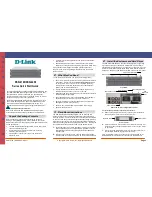
SDP3B FlashDisk Product Manual
SanDisk SDP3B FlashDisk Product Manual © 1998 SANDISK CORPORATION
23
Table 4-2 Signal Description
Signal Name
Dir.
Pin
Description
A10 - A0
(PC Card Memory Mode)
I
8, 11, 12, 22,
23, 24, 25, 26,
27, 28, 29
These address lines along with the -REG signal are used to
select the following: The I/O port address registers within the
SDP3B FlashDisk, the memory mapped port address registers
within the card, a byte in the card's information structure and its
configuration control and status registers.
A10 - A0
(PC Card I/O Mode)
This signal is the same as the PC Card Memory Mode signal.
A2 - A0
(True IDE Mode)
A10 - A3
(True IDE Mode)
I
27, 28, 29
In True IDE Mode only A[2:0] are used to select the one of eight
registers in the Task File.
In True IDE Mode, these remaining address lines should be
grounded by the host.
BVD1
(PC Card Memory Mode)
I/O
63
This signal is asserted high as the BVD1 signal since a battery
is not used with this product.
-STSCHG
(PC Card I/O Mode)
Status Changed
This signal is asserted low to alert the host to changes in the
RDY/-BSY and Write Protect states, while the I/O interface is
configured. Its use is controlled by the Card Config and Status
Register.
-PDIAG
(True IDE Mode)
In the True IDE Mode, this input / output is the Pass Diagnostic
signal in the Master / Slave handshake protocol.
BVD2
(PC Card Memory Mode)
I/O
62
This output line is always driven to a high state in Memory Mode
since a battery is not required for this product.
-SPKR
(PC Card I/O Mode)
This output line is always driven to a high state in I/O Mode
since this product does not support the audio function.
-DASP
(True IDE Mode)
In the True IDE Mode, this input/output is the Disk Active/Slave
Present signal in the Master/Slave handshake protocol.
-CD1, -CD2
(PC Card Memory Mode)
O
36, 67
These Card Detect pins are connected to ground on the SDP3B
FlashDisk. They are used by the host to determine if the product
is fully inserted into its socket.
-CD1, -CD2
(PC Card I/O Mode)
This signal is the same for all modes.
-CD1, -CD2
(True IDE Mode)
This signal is the same for all modes.
-CE1, -CE2
(PC Card Memory Mode)
Card Enable
I
7, 42
These input signals are used both to select the card and to
indicate to the card whether a byte or a word operation is being
performed. -CE2 always accesses the odd byte of the word.
-CE1 accesses the even byte or the Odd byte of the word
depending on A0 and -CE2. A multi-plexing scheme based on
A0, -CE1, -CE2 allows 8 bit hosts to access all data on D0-D7.
See Tables 4-11, 4-12, 4-15, and 4-16.
-CE1, -CE2
(PC Card I/O Mode)
Card Enable
This signal is the same as the PC Card Memory Mode signal.
-CS0, -CS1
(True IDE Mode)
In the True IDE Mode -CS0 is the chip select for the task file
registers while -CS1 is used to select the Alternate Status
Register and the Device Control Register.
















































